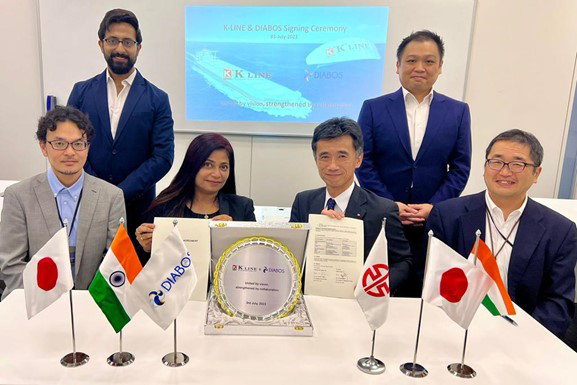Kawasaki Kisen Kaisha, Ltd. (“K” LINE) signed a service contract agreement on port expense settlement services with DIABOS Global (DIABOS) in July 2023. DIABOS is a company in the JM Baxi Group, which is “K” LINE’s business partner in India. Based in Mumbai, its expertise is contracted services for port expense settlement, serving a large number of shipping companies around the world. With an abundance of practical experience, it has accumulated a great deal of related data.
“K” LINE is pressing ahead with digital transformation from five perspectives specified in its DX Strategy*¹, namely DX ashore, DX at sea, DX of data, DX of human resources and security that supports DX. As an initiative for DX ashore and for DX of data, it is set to introduce the VESON IMOS Platform (VIP) in 2024. It is a platform provided by Veson Nautical (Veson) to cover a series of ship operation management processes including charter contract conclusion, financial management and fuel management. Today, “K” LINE operates the tramp service business -*² globally. The agreement is aimed at increasing “K” LINE’s business efficiency and budget management accuracy and broadly improving its business quality by outsourcing to DIABOS port expense processing operations, including assessment and journalizing of port expenses that occurs in huge numbers every day and data entries into the VIP system.
At “K” LINE, digitalization is underway as a functional strategy for realizing the business strategy in the medium-term management plan announced in May 2022. With the use of data and digital technologies, “K” LINE will enhance the core values of safety, the environmental conservation and quality in a bid to boost its competitiveness and corporate value.

“K” LINE:Kohei Morita(General Manager of Drybulk Planning Group)
Diabos:Mr. Rohit Khera
Diabos:Ms. Meera Kumar (CEO)
“K” LINE:Masatoshi Taguchi(Managing Executive Officer)
“K” LINE (INDIA) PRIVATE LIMITED:Chengwen Cheang
“K” LINE:Eisuke Hayashi(Bulk Carrier Group)
*¹DX Strategy 2023 (announced on December 22, 2022)
https://www.kline.co.jp/en/sustainability/dx_strategy.html
*²Car carrier transport is excluded.











